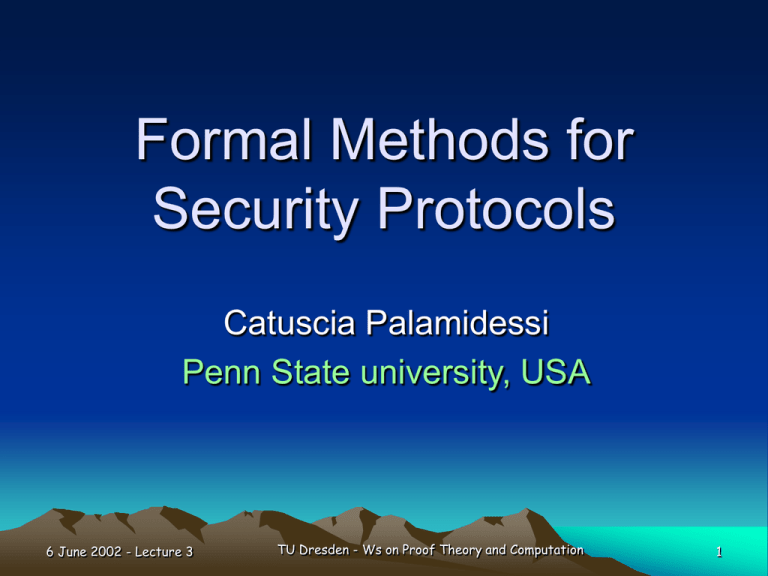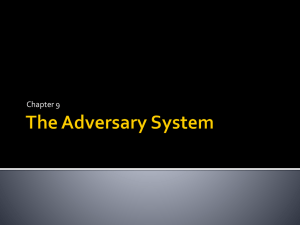Lecture 3
advertisement

Formal Methods for
Security Protocols
Catuscia Palamidessi
Penn State university, USA
6 June 2002 - Lecture 3
TU Dresden - Ws on Proof Theory and Computation
1
Security Protocols
Contents of previous lectures:
• Brief introduction to security protocols
• Aims and properties
• authentication, secrecy, integrity, anonymity, etc.
• Brief introduction to Cryptographic tools
• Symmetric and asymmetric cryptography
• one-way functions, door traps
• Vulnerability of Security protocols
• Next: Introduction to Concurrency
6 June 2002 - Lecture 3
TU Dresden - Ws on Proof Theory and Computation
2
Brief introduction to Concurrency
• The CSP approach
• Communicating Sequential Processes [Hoare 78]
• Mathematical framework for the description and
analysis of systems consisting of processes
interacting via exchange of messages
• Automatic tools available for proving properties of
CSP specifications:
• Model-checker FDR
• Theorem prover PVS
6 June 2002 - Lecture 3
TU Dresden - Ws on Proof Theory and Computation
3
The CSP formalism
• A small mathematical language containing the
main constructs for specifying concurrency,
parallelism, communication, choice, hiding etc.
• The evolution of processes is based on a sequence
of events or actions
• Visible actions S
• Interaction with other processes, communication
• Invisible action t
• Internal computation steps
6 June 2002 - Lecture 3
TU Dresden - Ws on Proof Theory and Computation
4
The CSP language: Syntax
• Inaction: Stop
•
• Termination, deadlock, incapability of performing any action,
either internal or external
Input: in ? x : A g P(x)
• Execute an input action on channel in, get message x of type A,
then continue as P(x)
• Output: out ! m g P(x)
•
• Execute an output action on channel out, send message m, then
continue as P(x)
Recursion: P(y1,…,yn) = Body(y1,…,yn)
• Process definition. P is a process name, y1,…,yn are the
parameters, Body(y1,…,yn) is a process expression
• Example: Copy = in ? x g out ! m g
6 June 2002 - Lecture 3
Copy
TU Dresden - Ws on Proof Theory and Computation
5
The CSP Syntax
• External (aka guarded) choice: P [] Q
• Execute a choice between P and Q. Do not choose a process
which cannot proceed
• Example: (a ? x g P(x)) [] (b ? x g Q(x))
Execute one and only one input action. If only one is available
then choose that one. If both are available than choose
arbitrarily. If none are available then block. The unchoosen
branch is discarded (commitment)
• Internal choice: P + Q
• Execute an arbitrary choice between P and Q. It is possible to
choose a process which cannot proceed
6 June 2002 - Lecture 3
TU Dresden - Ws on Proof Theory and Computation
6
The CSP Syntax
• Parallel operator w/synchronization: P || Q
• P and Q proceed in parallel and are obliged to synchronize on all the
common actions
• Example: (c ? x g P(x)) || (c ! m g Q)
• Synchronization: the two processes can proceed only if their actions
correspond
• Handshaking: sending and receiving is simultaneous (clearly an
abstraction. Buffered communication can anyway be modeled by
implementing a buffer process)
• Communication: m is transmitted to the first process, which continues as
P(m).
• Broadcasting: c ! m is available for other parallel procs
•
Question: what happens with the process
((c?xgP(x)) [] (d?y gQ(y))) || (c!m gR)
6 June 2002 - Lecture 3
TU Dresden - Ws on Proof Theory and Computation
7
The CSP Syntax
• Parallel operator w/synchronization and interleaving:
P ||AQ
• P and Q are obliged to synchronize only on the common actions
in A
• They interleave on all the actions not in A
• Example: (c ? x gP(x)) ||{c} ((c ! m gQ) [] (d ! n g R))
• the two processes can either synchronize on the action on
channel c, or the second process can perform an action on d. In
this second case the first process will remain blocked, though,
until the second will decide to perform (if ever) an output action
on c.
• Question: in what part of the second process could this action
on c be performed ?
• Abbreviation: P ||| Q stands for P ||f Q
6 June 2002 - Lecture 3
TU Dresden - Ws on Proof Theory and Computation
8
The CSP’s Syntax
• Hiding: P \ A
• P \A behaves as P except that all the actions in A are
turned into invisible actions. So they cannot be used
anymore to synchronize with other processes.
• One possible use of this mechanism is to avoid that
external processes interfere with the communication
channels in P. (Internalization of communication in P.)
• Renaming: P[y/x]
• P[x/y] behaves as P except that all the occurrences of x
are renamed by y.
• Typically this serves to create different instances of the
same process scheme
• Abbr: P[y1,y2 /x1,x2] will stand for P[y1/x1][y2/x2]
6 June 2002 - Lecture 3
TU Dresden - Ws on Proof Theory and Computation
9
Modeling Security Protocols in CSP
Security protocols work through the
interaction of a number of processes in
parallel that send messages to each other.
A formalism for concurrency is therefore
an obvious notation for describing the
participants and their role in the protocol
•
Example: The Yahalom protocol
Message
Message
Message
Message
6 June 2002 - Lecture 3
1
2
3
4
agb:
bgs:
sga:
agb:
a.na
b.{a.na.nb}ServerKey(b)
{b. kab.na.nb}ServerKey(a) .{a.kab}ServerKey(b)
{a. kab}ServerKey(b) .{nb}kab
TU Dresden - Ws on Proof Theory and Computation
10
Modeling Security Protocols in CSP
• We assume that each process has channels
• Receive
• Send
that it uses for all communications with the
other nodes via the medium
• Let us assume that A (Alice) and B (Bob) use
the protocol, with A as initiator and B as
responder, and that J (Jeeves) is the secure
server
6 June 2002 - Lecture 3
TU Dresden - Ws on Proof Theory and Computation
11
Modeling Security Protocols in CSP
• A ’s view (initiator):
• Message 1 a sends to b: a.na
• Message 3 a gets from j: {b. kab.na.nb}ServerKey(a) .{a.kab}ServerKey(b)
• Message 4 a sends to b: {a. kab}ServerKey(b) .{nb}kab
• In CSP this behavior can be modeled as follows:
Initiator(a,na ) =
env?b: Agent
g send.a.b.a.na
g [] (receive.J.a{b. kab.na.nb}ServerKey(a) .m
g send.a.b.m.{nb}kab g Session(a,b,kab,na,nb) )
kab e Key
nb e Nonce
meT
6 June 2002 - Lecture 3
TU Dresden - Ws on Proof Theory and Computation
12
Modeling Security Protocols in CSP
• B ’s view (responder):
• Message 1 b gets from a: a.na
• Message 2 b sends to j: b.{a.na.nb}ServerKey(b)
• Message 4 b gets from a: {a. kab}ServerKey(b) .{nb}kab
• In CSP this behavior can be modeled as
follows:
Responder(b,nb ) =
[] (receive.a.b.a.na g send.b.J.b .{a.na.nb}ServerKey(b)
g receive.a.b.{a. kab}ServerKey(b) .{nb}kab
kab e Key
g Session(b,a,kab,na,nb) )
nb e Nonce
meT
6 June 2002 - Lecture 3
TU Dresden - Ws on Proof Theory and Computation
13
Modeling Security Protocols in CSP
• J’s view (server):
• Message 2 j gets from ‘b’: b.{a.na.nb}ServerKey(b)
• Message 3 j sends to a : {b. kab.na.nb}ServerKey(a) .{a.kab}ServerKey(b)
• In CSP this behavior can be modeled as follows:
Server(J,kab ) =
[] (receive.b.J.b .{a.na.nb}ServerKey(b)
g send.J.a. {b. kab.na.nb}ServerKey(a) .{a.kab}ServerKey(b)
A,B e Agent
g Server(J,ks ) )
Nb ,nb e Nonce
Server(J) = ||| Server(J,kab )
kab e KeysServer
Question: why several server processes in parallel?
6 June 2002 - Lecture 3
TU Dresden - Ws on Proof Theory and Computation
14
Modeling an intruder
• We want to model an intruder that
represents all potential intruder behaviors
Intruder(X) = learn ? m: messages gIntruder(close(X U {m})
[]
say ! m: X /\ messages gIntruder(X)
• Close(X) represents all the possible information that the
attacker can infer from X. Typically we assume:
• Dolew-Yao Assumptions:
•
•
•
•
k , m |- {m}k
{m}k , k-1 |- m
<x1, … ,xn> |- xi
x1 , … , xn |- <x1,…,xn>}
6 June 2002 - Lecture 3
TU Dresden - Ws on Proof Theory and Computation
15
Putting the network together
Initiator(Alice,nA)[fake,take/receive,send]
|||
Responder(Bob,nB)[fake,take/receive,send]
|||
Server(Jeeves)[fake,take/receive,send]
|||
Intruder(f)[take.x.y,fake.x.y/learn,say]
Bob
send
receive
Jeeves
Alice
receive
send
fake.x.Bob
receive
send
take.Alice.y
6 June 2002 - Lecture 3
learn
Yves
say
TU Dresden - Ws on Proof Theory and Computation
16
Alternative with direct channels
S =[fake,comm,take,comm,/receive,send,receive,send]
Initiator(Alice,nA)[S]
|||
Responder(Bob,nB)[S]
|||
Server(Jeeves)[S]
|||
Intruder(f)[S]
Bob
send
receive
Comm.Alice.Bob
Jeeves
Alice
fake.x.Bob
receive
receive
send
send
take.Alice.y
6 June 2002 - Lecture 3
learn
Yves
say
TU Dresden - Ws on Proof Theory and Computation
17
Expressing Security Properties in CSP
• Security properties: the goals that a protocol is
meant to satisfy, relatively to specific kinds and
levels of threat – the intruders and their capabilities
• We will consider the following security properties:
• Secrecy
• messages, keys, etc. have not become known
• Authentication
• Guarantees about the parties involved in the protocol
• Non-repudiation
• Evidence of the involvement of the other party
• Anonymity
• Protecting the identity of agents wrt particular events
6 June 2002 - Lecture 3
TU Dresden - Ws on Proof Theory and Computation
18
Anonymity
• We will model events as consisting of two
components: the event itself, x, and the identity of
the agent performing the event, a
a.x
• AnUsers: the users who want to remain secret
• Given x, define
A = {a.x | a e AnUsers }
• Definition: A protocol described as a CSP
system P provides anonymity if an arbitrary
permutation of the events in A, applied to all
the traces of P, does not alter the set of all
possible traces of P
6 June 2002 - Lecture 3
TU Dresden - Ws on Proof Theory and Computation
19
Anonymity
• Traces of a process: the sequences of visible actions
in all possible runs
• Example:
Traces:
a.b.c.d
• Example:
Traces:
a -> b -> Stop ||| c -> d -> Stop
a.c.b.d c.a.b.d a.c.d.b c.a.d.b c.d.a.b
a -> b -> c -> Stop ||{b} d -> b -> e -> Stop
a.d.b.c.e
6 June 2002 - Lecture 3
d.a.b.c.e
a.d.b.e.c
d.a.b.e.c
TU Dresden - Ws on Proof Theory and Computation
20
Anonymity
• Let AnUsers = {p1,p2}
• Let A = {p1.m, p2.m}
• Example 1
• Example 2
• Example 3
p1.m -> p2.m -> Stop
p1.m -> Stop ||| p2.m -> Stop
p1.m -> Stop + p2.m -> Stop
• Question: for each system, say whether or
not it provides anonymity wrt A
6 June 2002 - Lecture 3
TU Dresden - Ws on Proof Theory and Computation
21
Anonymity
• A more involved example:
P = p1. m -> a -> Stop [] p2. m -> a -> Stop
||{p1.m , p2.m }
p1. m -> b -> Stop [] p2. m -> c -> Stop
Question: Does P provides anonymity wrt
A = {p1.m, p2.m}
6 June 2002 - Lecture 3
TU Dresden - Ws on Proof Theory and Computation
22
• Answer: No
Anonymity
P has traces (p1.m).b.a , (p2.m).c.a , …
but not (p2.m).b.a , (p1.m).c.a , …
The permutation { p1 -> p2 , p2 -> p1 } changes the traces.
• However, if we assume that the observer has no
visibility of the actions b and c, then the system does
provide anonymity wrt A = {p1.m, p2.m}
• One elegant way to formalize the concept of visibility
in CSP is to use the the hiding operator:
P\{b, c} provides anonymity wrt A
• Note: Hiding A would not be correct. Example: p1.m -> Stop
6 June 2002 - Lecture 3
TU Dresden - Ws on Proof Theory and Computation
23
Anonymity
• In general, given P, consider the sets:
• A = {a.x | a e AnUsers } : the actions that we want to know
only partially (we want to know x but not a)
• B : the actions that we want to observe
• C = Actions – (B U A) : The actions we want to hide
A
The system to consider for the
Anonymity analysis:
P\C
B
6 June 2002 - Lecture 3
C
Method: for any perm r : A -> A
Check that
r (traces(P\C)) = traces(P\C)
TU Dresden - Ws on Proof Theory and Computation
24
The dining cryptographers
• Three cryptographers share a meal
• The meal is paid either by the organization
(master) or by one of them. The decision on
who pays is taken by the master
• Each of them is informed by the master
whether or not he is paying
• GOAL: The cryptographers would like to know
whether the organization is paying or not, but
without knowing the identity of the
cryptographer who is paying (if any).
6 June 2002 - Lecture 3
TU Dresden - Ws on Proof Theory and Computation
25
The dining cryptographers
• Solution: Each cryptographer tosses a coin. Each coin
is in between two cryptographers.
• The result of each coin-tossing is visible to the
adjacent cryptographers, and only to them.
• Each cryptographer examines the two adjacent coins
• If he is not paying, he announces “agree” if the results are
the same, and “disagree” otherwise.
• If he is paying, he says the opposite
• Claim: if the number of “disagree” is even, then the
master is paying. Otherwise, one of them is paying. In
the latter case, the non paying cryptographers will
not be able to deduce whom exactly is paying
6 June 2002 - Lecture 3
TU Dresden - Ws on Proof Theory and Computation
26
Example: The dining cryptographers
Crypt(0)
notpays.0
pays.0
Coin(0)
Coin(1)
Master
out.1
Crypt(1)
6 June 2002 - Lecture 3
Coin(2)
look.2.0
Crypt(2)
TU Dresden - Ws on Proof Theory and Computation
27
The dining cryptographers
• Specification in CSP: Master and Coins
Master =
Sn pays.n -> notpays.(n+1) -> notpays (n+2) -> Stop
+ notpays.0 -> notpays.1 -> notpays.2 -> Stop
Coin(n) = Heads(n) + Tails(n)
Heads(n) = look.n.n.hd ->Stop ||| look.(n-1).n.hd ->Coin(n)
Tails(n) = look.n.n.tl -> Stop ||| look.(n-1).n.tl ->Coin(n)
•
Note: the arithmetic operations are modulo 3
6 June 2002 - Lecture 3
TU Dresden - Ws on Proof Theory and Computation
28
The dining cryptographers
• Specification in CSP: Cryptographers
Crypt(n) = notpays(n) -> Check(n)
[] pays(n) -> Check’(n)
Check(n) = look.n.n?x -> look.n.(n+1)?y ->
if (x=y) then out.n. agree -> Stop
else out.n. disagree -> Stop
Check’(n) = look.n.n?x -> look.n.(n+1)?y ->
if (x=y) then out.n. disagree -> Stop
else out.n. agree -> Stop
6 June 2002 - Lecture 3
TU Dresden - Ws on Proof Theory and Computation
29
The dining cryptographers
• Specification in CSP: The whole system
Crypts = Crypt(0) ||| Crypt(1) ||| Crypt(2)
Coins = Coin(0) ||| Coin(1) ||| Coin(2)
Meal = Master ||{pays, notpays} ( Coins ||{look} Crypts )
6 June 2002 - Lecture 3
TU Dresden - Ws on Proof Theory and Computation
30
The dining cryptographers
• The anonymity property
• A = { pays.0, pays.1, pays.2 }
• B = { out }
• C = Actions – (B U A) = {look,notpays}
• Theorem: For every permutation r: A -> A, we have
r(Traces(Meal\C)) = traces(Meal\C)
• This theorem means that an external observer cannot infer
which cryptographer has paid.
• This theorem can be proved by using the automatic tool FDR.
6 June 2002 - Lecture 3
TU Dresden - Ws on Proof Theory and Computation
31
The dining cryptographers
• One can argue that previous result is not strong enough: a
cryptographer has more information than an external observer.
Let us then do the analysis for a cryptographer, say Crypt(0)
A = { pays.1, pays.2 }
B = { pays.0, notpays.0, look.0, out }
C = Actions – (B U A)
• Theorem: For every permutation r: A -> A, we have
r(traces(Meal\C)) = traces(Meal\C)
•
This means that if Crypt(1) or Crypt(2) pay, then Crypt(0) can’t infer
which of them has paid. The same can be shown for the other two. So
Meal\C provides the desired anonymity property.
6 June 2002 - Lecture 3
TU Dresden - Ws on Proof Theory and Computation
32
The dining cryptographers
• Example of a case in which the anonymity property
does not hold.
• Assume that Crypt(0) can access the result of the third coin,
namely has visibility of the result of the action look.2.2
A = { pays.1, pays.2 }
B = { pays.0, notpays.0, look.0, out } U { look.2.2 }
C = Actions – (B U A)
• We have that for some permutation r: A -> A,
r(traces(Meal\C)) =/= traces(Meal\C)
pays.2 notpays.0 look.00.heads look.0.1.heads look.2.2.heads out.2.disagree YES
pays.1 notpays.0 look.00.heads look.0.1.heads look.2.2.heads out.2.disagree NO
6 June 2002 - Lecture 3
TU Dresden - Ws on Proof Theory and Computation
33









